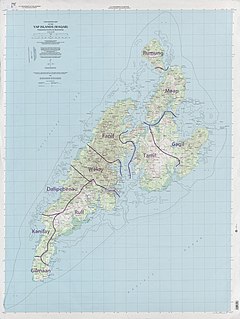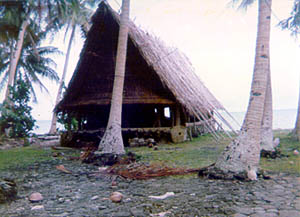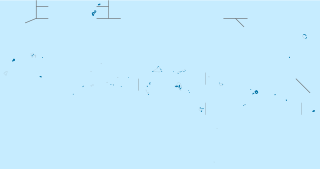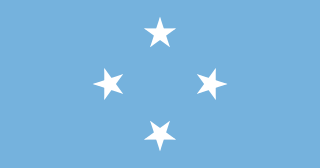
Weno is an island municipality of Chuuk State of the Federated States of Micronesia (FSM). It is the largest town in the FSM.

Colonia is an urban area belonging to the municipalities of Rull and Weloy, which serves as the capital of the State of Yap, one of the Federated States of Micronesia. It administers both Yap proper and some 13 atolls and islands reaching to the east and south for some 800 km (500 mi).
Tonoas, also known by its Spanish name of Dublon, is an island in the Chuuk lagoon, Federated States of Micronesia. It has an area of 8.8 km² and the population was 3,200 at the time of the last census (1980). A narrow single-lane track rings the island, allowing land access to the small villages Five schools and Japanese military ruins, which include the remains of a seaplane anchorage and large fuel storage tanks. A Japanese administrative centre dating from the 1920-1930s mandate period can still be found, and is currently used as a government building.
Dinay is a village belonging to the municipality of Rull in the southern part of the island of Yap in the Federated States of Micronesia. The village was added to the United States National Register of Historic Places in 2004. It is unique in Micronesia as the site of an ancient pottery complex, and is probably one of the earliest settlements on the island. The ancient village complex includes more than a dozen family platforms (daf) of such age that local folklore has forgotten their lineages, normally a significant cultural feature of such sites. The period of occupation is estimated to have been between about 3000 BCE and 1600 CE.

Rull is a municipality in the southern part of the island Yap, Federated States of Micronesia. It has a traditional dancing ground. Rull has a population of 1,847. The historic Rull Men's Meetinghouse is located within the town.

Xavier High School is a Jesuit coeducational high school located on the island of Weno in Chuuk, Federated States of Micronesia. It was established in 1952. It was the first high school in the Trust Territory of the Pacific Islands. Bishop Thomas Feeney, S.J., D.D. from the New York Province of the Society of Jesus originally envisioned a minor seminary to train local clergy. Soon after, Xavier Seminary became the first college preparatory school in the Western Pacific.

Dalipebinau is a village and municipality in the state of Yap, Federated States of Micronesia. It lies on the west side of the Yap island, north of Yap International Airport.

The Rull Men's Meetinghouse is a historic meeting house in Rull, a village on the island of Yap in the Federated States of Micronesia. It is a large rectangular structure, set on a raised stone platform. The flooring consists of treated betelnut palm trunks, and has a steeply pitched roof made of bamboo supports with various types of tropical leaves tied in place using coconut fiber. The faluw, although not the first built on this platform, has historically occupied a central place in the civic life of the community, serving as a place where the men of the village could meet in seclusion, and as a place for social rites.

The Catholic Belltower is a historic tower at the Catholic Mission in Kolonia, on the island of Pohnpei in the Federated States of Micronesia. The belltower and adjoining masonry apse are all that remain of a church built in 1909 by German Capuchin missionaries, when Ponape and the other Caroline Islands were administered as part of German New Guinea. The rest of the church was destroyed during the fighting of World War II. The tower is 4.8 metres (16 ft) square, rising to a height of 20.7 metres (68 ft), and the shell of the apse is about 10 metres (33 ft) in height. The tower has a foundation of basalt rock and lime mortar, and is constructed out of concrete bricks.

The Wiichen Men's Meetinghouse is a historic building site in Peniesene on Moen Island in Chuuk State of the Federated States of Micronesia. The site, deemed archaeologically significant due to its place in Chuukese folklore, includes a pre-contact period petroglyph panel and swimming basin. Local history claims that this was the meeting place of six brothers who became the first chieftains of Chuuk.

The Japanese Lighthouse, or Poluwat Lighthouse, is an abandoned lighthouse situated on Alet Island in Poluwat, Chuuk in the Federated States of Micronesia. It was completed in 1940 by the Japanese and was in use until being attacked by U.S. forces in World War II. It was listed on the National Register of Historic Places in 1983. The lighthouse is a good example of pre-World War II "marine architecture" built by the Japanese.

Leluh is a major prehistoric and historic archaeological site, encompassing the remains of a city on Lelu Island, a satellite of the larger island of Kosrae in the Federated States of Micronesia. The remains are those of a civilization that peaked around the 14th and 15th centuries, with elements still visible at the time of European contact in the early 19th century.
Safonfok is a prehistoric archaeological site near Walung, on the island of Kosrae in the Federated States of Micronesia. At the time of its discovery in 1999, it was one of the largest prehistoric industrial complex found in the islands of the Pacific. The site, whose extent has not been fully determined, was excavated in 1999-2000, revealing a major complex where an estimated hundreds of workers manufactured coral fish hooks and other tools. Unique among the finds are a basalt knife and a diamond-shaped bead.

The World War II Japanese Army Headquarters for the defense of Tonowas, an island in what is now Chuuk State in the Federated States of Micronesia, was located in an underground bunker in the village of Roro. The underground facilities, including an office, communications center, print shop, supply room, and health clinic, were built in response to American air raids against the facilities, which were associated with the major naval facility of the Imperial Japanese Navy in Chuuk Lagoon.

Likinlulem is a major archaeological site on the island of Kosrae in the Federated States of Micronesia. The site encompasses more than 7 acres (2.8 ha) on either side of Likinlulem Stream on the island's southwestern coast, in an area that is now overgrown mangrove swamp. It includes at least nine large enclosures with extensive internal features, a channelized stream, canoe landing, and a large open platform that is subject to inundation at high tide. Occupancy of the site has been dated to 1200-1800 CE, with one area possibly dating as far back as 1000 CE. The site is an important element of the island's oral history as it was here that its paramount chiefs are said to have held court prior to the ascendancy of Leluh c. 1400. When the site was listed on the United States National Register of Historic Places in 2004, it had been surveyed but not extensively excavated.
The Fauba Archaeological Site is a prehistoric stoneworks on a mountain ridge on Tol Island in Chuuk State of the Federated States of Micronesia. The site consists of an area enclosed by a stone wall that is roughly triangular in shape. The wall is between 1 and 1.5 meters in height, and is about 1 meter thick. The enclosed area includes a number of stone platforms, and there is a refuse midden outside the enclosure that is believed to be associated with the site. The exact purpose of the site is a subject of debate: although its siting has obvious military benefits (including commanding views of Chuuk Lagoon and other islands of the atoll, it is not clear that it actually saw military activity.












